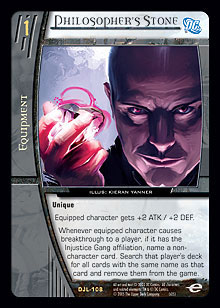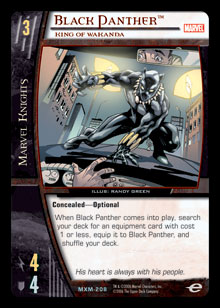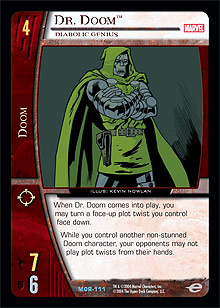Welcome back to Deck Clinic. This week, we’re taking one of the premier aggressive characters in the game—a staple of one of the most notorious Golden Age decks around—and giving him a little twist. Don’t worry, he won’t mind.
Submitter: Epoch on VSRealms.com
Black Panther and the Philosopher’s Stone (with apologies to JK Rowling):
Characters
4 Dagger, Child of Light
2 Mikado and Mosha, Angels of Destruction
4 Poison Ivy, Deadly Rose
2 Puppet Master, Philip Masters
4 Black Panther, King of Wakanda
4 Pan, Manhunter Duplicate
1 Ragman, Rory Regan
4 Daredevil, Matt Murdock
2 Spider-Man, The Spectacular Spider-Man
2 Magneto, Master of Magnetism
1 Apocalypse, En Sabah Nur
Plot Twists
4 Wild Ride
4 Midnight Sons
4 Blind Sided
3 Removed from Continuity
2 Enemy of My Enemy
Locations
4 The Source
3 Slaughter Swamp
2 Metropolis
Equipment
4 Philosopher’s Stone
Epoch says, “This is a deck that I have been playing around with. Basically, it tries to take away plot twists and other resources that my opponent needs. It is a little inconsistent, but I feel that it could work well.”
Well, if there’s one thing I can help with, it’s consistency. And maybe—just maybe—I can help the deck in other ways, too. Let’s see what we can do!
First of all, here’s a rundown of the key components of the deck.
 1) The most obvious specific interaction to take note of is Black Panther, King of Wakanda searching out Philosopher’s Stone. After that, use Midnight Sons to team-up Marvel Knights and Injustice Gang to benefit from the Stone’s triggered power, which allows us to name a non-character card and then strip all copies of that card from our opponent’s deck. It’s certainly an interesting twist for a character that is better known for searching out some Advanced Hardware and shooting his opponents in the kneecaps.
1) The most obvious specific interaction to take note of is Black Panther, King of Wakanda searching out Philosopher’s Stone. After that, use Midnight Sons to team-up Marvel Knights and Injustice Gang to benefit from the Stone’s triggered power, which allows us to name a non-character card and then strip all copies of that card from our opponent’s deck. It’s certainly an interesting twist for a character that is better known for searching out some Advanced Hardware and shooting his opponents in the kneecaps.
2) A flipped Midnight Sons naming New Gods will allow us to use The Source to ambush our opponent’s resource row. Pan, Manhunter Duplicate provides the final piece of the puzzle with the same breakthrough-triggered ability that Philosopher’s Stone provides.
3) Poison Ivy, Deadly Rose allows us to KO unneeded 1-drops to search for extra copies of The Source, or to team-up “the old-fashioned way” with Poison Ivy searching out a copy of Metropolis to team-up with Black Panther.
A Change of Direction
There are two areas in which I’m going to try to help this Deck Clinic patient. The first is the consistency issue raised by Epoch in his submission. Despite the presence of Wild Ride and Enemy of My Enemy, assembling all the pieces of the deck in every game is apparently not as smooth as we would like it to be.
The second direction of attack is to vary the number of ways in which we can attack our opponent’s deck. This is also the one that will likely result in the most substantial changes to the deck. At the moment, the first hit with Philosopher’s Stone is essentially blind. A lot of the time, we’ll probably end up calling a team-stamped search card based on what we’ve seen so far, or Enemy of My Enemy, or a card our opponent has already played a copy of. None of those choices are optimal. Hitting a critical unseen card on turn 3 rather than trying to hit it on turn 4 could be the difference between winning and losing in a format with as many search cards as Golden Age has.
If we’re making significant structural changes to the deck, we’ll have to decide on those before we start working on consistency issues, so I’m going to give a brief rundown of the direction in which I’m going to take the deck.
 The main weak points on the curve, as I see them, are with the 2-drop and the 4-drop. Black Panther, King of Wakanda is excellent at 3; Dagger, Child of Light and Mikado and Mosha, Angels of Destruction are 1-cost workhorses (although I would add a copy of Micro-Chip, Linus Lieberman); and Daredevil, Matt Murdock and Spider-Man, The Spectacular Spider-Man are strong options at 5 and 6 respectively. At the 2-drop slot, though, Poison Ivy suffers from a lack of characters to KO to her ability. Without any alternate recruit–cost characters, Poison Ivy’s text box only matters if we hit our 1-drop, and we will likely have to KO that 1-drop to fetch Slaughter Swamp to get the 1-drop back anyway, since we’ll want to discard it to search for Midnight Sons or stun a 1-drop. While Ivy is nice and her 3 ATK / 3 DEF stats are very welcome, she doesn’t really advance our key game plan. Puppet Master, Philip Masters is better for this because his exhaustion power can mess with our opponent’s ability to reinforce; however, without any additional exhaustion effects or a way to give Black Panther, King of Wakanda flight, our opponent will be able to work around it.
The main weak points on the curve, as I see them, are with the 2-drop and the 4-drop. Black Panther, King of Wakanda is excellent at 3; Dagger, Child of Light and Mikado and Mosha, Angels of Destruction are 1-cost workhorses (although I would add a copy of Micro-Chip, Linus Lieberman); and Daredevil, Matt Murdock and Spider-Man, The Spectacular Spider-Man are strong options at 5 and 6 respectively. At the 2-drop slot, though, Poison Ivy suffers from a lack of characters to KO to her ability. Without any alternate recruit–cost characters, Poison Ivy’s text box only matters if we hit our 1-drop, and we will likely have to KO that 1-drop to fetch Slaughter Swamp to get the 1-drop back anyway, since we’ll want to discard it to search for Midnight Sons or stun a 1-drop. While Ivy is nice and her 3 ATK / 3 DEF stats are very welcome, she doesn’t really advance our key game plan. Puppet Master, Philip Masters is better for this because his exhaustion power can mess with our opponent’s ability to reinforce; however, without any additional exhaustion effects or a way to give Black Panther, King of Wakanda flight, our opponent will be able to work around it.
At the 4-drop slot, Pan, Manhunter Duplicate suffers badly from a not-so-hot body and a lack of flight and range. The Black Panther / Pan curve has another problem: a serious lack of off-initiative oomph with no real way to stop our opponent from mauling our board when he or she attacks first. This is not helped by Pan’s weak DEF.
So, we’re looking for a replacement 2-drop and a replacement 4-drop, and we’re ideally looking for characters that will complement our resource disruption plan, help us push through attacks for breakthrough when we have the initiative, and disrupt our opponent when he or she tries to attack us.
Special Guest Starring . . .
So, I hear you cry, what powerhouse could give us all these things? What tour de force of heroism or villainy could be so powerful both on and off initiative while taking some time out to mess with our opponent’s head and make us a tasty sandwich?
Ah, Victor—there you are. I think you wanted to say a few words?
Ahhh . . . Another comes before Doom, grovelling for his aid. Know, puny one, that Doom’s unbridled power and fury should not be taken for granted! Doom exacts a heavy cost for his allegiance, and you should but hope that your soul is weighty enough a bargaining chip to satisfy him. For now this “Philosopher’s Stone” is a bauble of enough interest to earn Doom’s attention, and he will consider your proposal once that petty “King” T’Challa brings it before Doom on bended knee. Now go! Doom grows weary of your presence!
Ahem . . . Thanks for that, Doctor. And I was only kidding about the sandwich. Really. No, I like my skin right where it is, thanks.
 Dr. Doom, Diabolic Genius has answered our call, and he provides a fantastic upgrade from the relatively weak Pan. And where Doom goes, Boris, Personal Servant of Dr. Doom also goes, his Tardis-like bags packed full of tricks ranging from Mystical Paralysis and the devastating Reign of Terror to the more subtle (and, for us, appropriate) Time Thief. It’s this last card that gives our deck a particular boost (although we’d be crazy to fail to include Paralysis or Reign in addition). Time Thief gives Philosopher’s Stone the precision it can lack the first time it hits. Rather than playing it safe and stripping out a likely search card, Time Thief lets us send in the Stone Panther, put the Stone’s breakthrough-triggered power on the chain, and then snipe our opponent with Time Thief before the Stone’s trigger resolves. Time Thief will do its thing (probably taking out a silver bullet that could cause us problems, or a one-of character like an 8-drop), and then, armed with full knowledge of our opponent’s deck (and, in fact, able to make a pretty good guess at what he or she has in the hand and resource row), the Stone will be more devastating than ever.
Dr. Doom, Diabolic Genius has answered our call, and he provides a fantastic upgrade from the relatively weak Pan. And where Doom goes, Boris, Personal Servant of Dr. Doom also goes, his Tardis-like bags packed full of tricks ranging from Mystical Paralysis and the devastating Reign of Terror to the more subtle (and, for us, appropriate) Time Thief. It’s this last card that gives our deck a particular boost (although we’d be crazy to fail to include Paralysis or Reign in addition). Time Thief gives Philosopher’s Stone the precision it can lack the first time it hits. Rather than playing it safe and stripping out a likely search card, Time Thief lets us send in the Stone Panther, put the Stone’s breakthrough-triggered power on the chain, and then snipe our opponent with Time Thief before the Stone’s trigger resolves. Time Thief will do its thing (probably taking out a silver bullet that could cause us problems, or a one-of character like an 8-drop), and then, armed with full knowledge of our opponent’s deck (and, in fact, able to make a pretty good guess at what he or she has in the hand and resource row), the Stone will be more devastating than ever.
If you want devastating, it can’t get much more unpleasant than Panther coming down on turn 3, followed by Doom, then followed by Reign of Terror returning your opponent’s 3-drop to his or her hand, then smashing the opposing 4-drop, thus leaving T’Challa free to smash for 6 direct breakthrough endurance loss and a Philosopher’s Stone trigger.
Of course, this leads us to the next question: is there a reasonable way for us to take advantage of Time Thief’s threshold cost of 3? That is, can we consistently get it to fire on turn 3 if we’ve drawn it? Happily, the answer is a resounding yes. Time Thief requires that we control either Dr. Doom or Kang, and we can actually satisfy both optional requirements without detracting from our evil schemes. Not only can we run Doomstadt (or Doomstadt, Castle Doom in a more aggressive deck like this one), but we can also run the dual-affiliated Kang, One of Many as our 2-drop of choice. Not only does he provide the “control Kang” for Time Thief, but he also (not coincidentally) allows us to exhaust our opponent’s characters to try to get that one un-reinforced attack through with Black Panther, King of Wakanda.
Check back for the next instalment of Deck Clinic, where I’ll go through the full rebuild of the deck and talk about some of the calls you might want to make if you have to resolve a Philosopher’s Stone trigger blind (without knowledge of your opponent’s deck via Time Thief).
Tom Reeve is a member of the Anglo-Canadian Alliance (like the Rebel Alliance, but with public transportation instead of X-Wings) and would-be professional layabout from London, England. While his love of all things ninja has resulted in an arguably unhealthy affinity for the League of Assassins, that particular quirk turned into a healthy plus with the birth of the Silver Age deck Deep Green, with which teammate Ian Vincent took home the Pro Circuit San Francisco trophy to dear old Blighty.